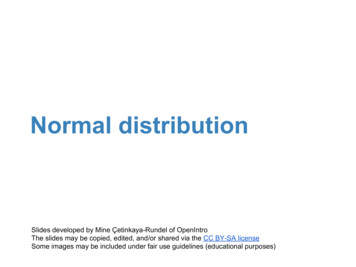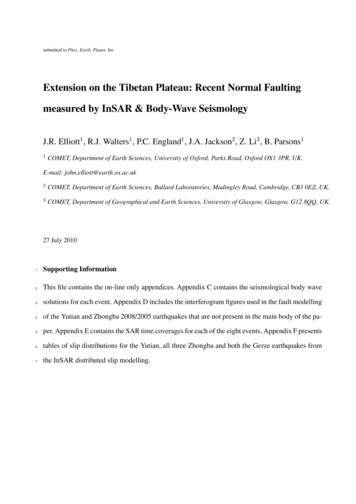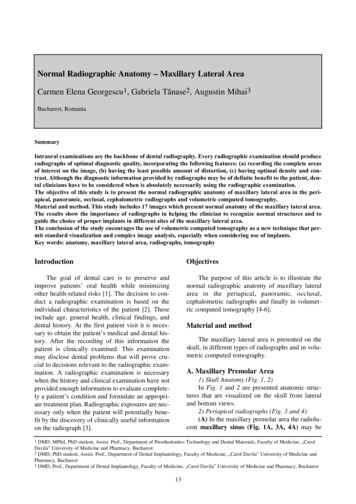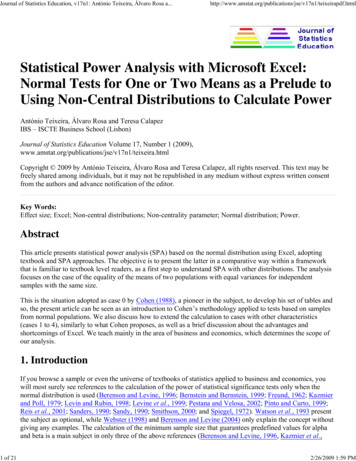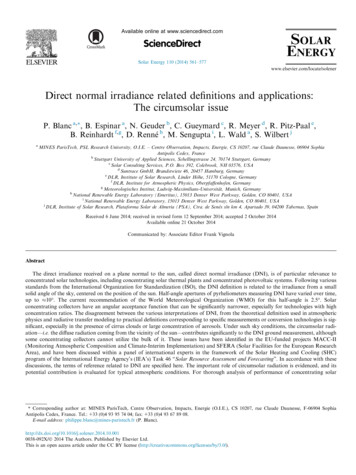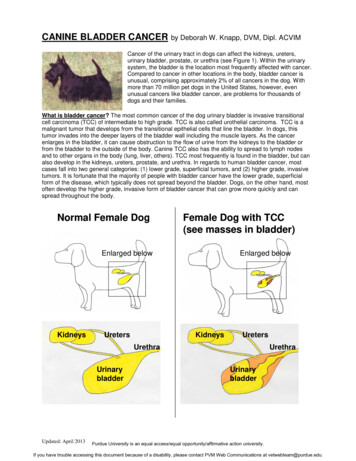
Transcription
CANINE BLADDER CANCERby Deborah W. Knapp, DVM, Dipl. ACVIMCancer of the urinary tract in dogs can affect the kidneys, ureters,urinary bladder, prostate, or urethra (see Figure 1). Within the urinarysystem, the bladder is the location most frequently affected with cancer.Compared to cancer in other locations in the body, bladder cancer isunusual, comprising approximately 2% of all cancers in the dog. Withmore than 70 million pet dogs in the United States, however, evenunusual cancers like bladder cancer, are problems for thousands ofdogs and their families.What is bladder cancer? The most common cancer of the dog urinary bladder is invasive transitionalcell carcinoma (TCC) of intermediate to high grade. TCC is also called urothelial carcinoma. TCC is amalignant tumor that develops from the transitional epithelial cells that line the bladder. In dogs, thistumor invades into the deeper layers of the bladder wall including the muscle layers. As the cancerenlarges in the bladder, it can cause obstruction to the flow of urine from the kidneys to the bladder orfrom the bladder to the outside of the body. Canine TCC also has the ability to spread to lymph nodesand to other organs in the body (lung, liver, others). TCC most frequently is found in the bladder, but canalso develop in the kidneys, ureters, prostate, and urethra. In regards to human bladder cancer, mostcases fall into two general categories: (1) lower grade, superficial tumors, and (2) higher grade, invasivetumors. It is fortunate that the majority of people with bladder cancer have the lower grade, superficialform of the disease, which typically does not spread beyond the bladder. Dogs, on the other hand, mostoften develop the higher grade, invasive form of bladder cancer that can grow more quickly and canspread throughout the body.Normal Female DogFemale Dog with TCC(see masses in bladder)Enlarged belowKidneysUretersEnlarged belowKidneysUretersUrethraUrinarybladderUpdated: April 2013UrethraUrinarybladderPurdue University is an equal access/equal opportunity/affirmative action university.If you have trouble accessing this document because of a disability, please contact PVM Web Communications at vetwebteam@purdue.edu.
What causes TCC in dogs? The exact cause of TCC in an individual dog is usually not known. Ingeneral, canine TCC results from a combination of several factors including genetic predisposition andenvironmental factors. A genetic predisposition is strongly suspected because TCC is more common inspecific breeds of dogs. Scottish Terriers have an 18-20 fold higher risk of TCC than other dogs.Shetland Sheepdogs, Beagles, West Highland White Terriers, and Wire Hair Fox Terriers are 3 to 5 timesmore likely to develop TCC than other dogs. Dogs in related breeds may also have a higher risk of TCC,but this has not been studied yet. Environmental factors identified as risk factors in early studies haveincluded pesticides and insecticides such as "old generation" flea dips. The greatest cause of TCC inhumans is smoking. Further study is needed to determine the extent to which second hand smoke couldcontribute to TCC in dogs.An association has been found between exposure to lawn herbicides and pesticides and the risk of TCCin Scottish Terriers. Investigators at the Purdue University School of Veterinary Medicine have publisheda case control study in Scottish Terriers to determine risk factors for the development of TCC. Asdiscussed above, Scottish Terriers have an 18-20 times higher risk for developing TCC than dogs of otherbreeds. The study was performed to determine if exposure to certain types of environmental chemicalswould further increase the risk of TCC in this breed of dog. Environmental exposure histories werecompared between 83 Scottish Terriers with TCC (cases) and 83 Scottish Terriers of approximately thesame age with other health-related conditions (controls). A significantly increased risk of TCC was foundfor dogs exposed to lawns or gardens treated with herbicides and insecticides or herbicides alone. In factdogs exposed to treated lawns were seven times more likely to develop TCC. These findings indicate thatScottish Terriers, as well as other dogs of high-risk breeds for TCC, should be restricted from lawnstreated with herbicides and pesticides. The risk of lawn chemicals to dogs in other breeds has not yetbeen determined.What clinical signs or symptoms do dogs with TCC have? Blood in the urine, straining to urinate, andmaking repeated frequent attempts to urinate are the most frequent signs of TCC in dogs. Pet ownersmust realize, however, that a urinary tract infection will cause these same symptoms, so the symptomsalone do not necessarily mean the dog has TCC. Less commonly, dogs with TCC can have lamenessdue to spread of the tumor into the bones or spread into the lungs and a paraneoplastic syndrome calledhypertrophic osteopathy.How is TCC diagnosed? A diagnosis of TCC requires a tissue biopsy. Several other types of growths inthe bladder, bladder infection, bladder stones, or bladder inflammation can cause similar symptoms asthose in dogs with TCC. Some of these other conditions can also cause "masses" to be seen onradiographs or ultrasound, and these other conditions can cause abnormal cells in the urine, which canbe mistaken for TCC. Therefore, the diagnosis of TCC requires a tissue biopsy. This is important becausethe treatment and prognosis depend entirely on exactly what is wrong with the bladder. A tissue biopsycan be obtained by surgery, cystoscopy (insertion of a fiberoptic scope into the bladder and biopsythrough the scope), or in some cases with a urinary catheter.What evaluation is needed for a dog with TCC? Once a diagnosis of TCC is made, it is important todetermine the extent of the tumor, i.e. to perform "tumor staging". Tumor staging is performed todetermine the best way to treat the cancer, to provide some information regarding prognosis, and toestablish a baseline set of tumor measurements in order to determine if subsequent treatment is beingsuccessful. Tumor staging for TCC includes radiographs (“x-rays”) of the thorax to look for lungmetastasis, radiographs and ultrasound (or CT scan) of the abdomen to look for metastasis in theabdomen and to assess any changes in the kidneys that result from obstructed urine flow, and imaging ofthe bladder to determine the exact location and size of the tumor within the bladder (see Figure 1). Thisinformation is needed to best plan how to treat the cancer. Also, these tests are repeated duringtreatment to know if the treatment is being effective.How is TCC treated? For dogs with TCC that has not spread beyond the bladder, surgical excision couldbe considered. In order to surgically excise the tumor, however, it needs to be located away from theneck (also called the trigone) of the bladder and the urethra. Several vital structures in the neck of thebladder (junction with ureters and urethra, urethral sphincter) usually prevent surgical excision of tumorsin this location. This is especially true because malignant tumors, like TCC, need to be removed with a"margin" of normal tissue around the tumor. This "margin" often contains microscopic tumor cells that, leftPurdue University is an equal access/equal opportunity/affirmative action university.If you have trouble accessing this document because of a disability, please contact PVM Web Communications at vetwebteam@purdue.edu.
behind, would result in cancer regrowth. In addition, most canine TCCs invade down into the bladder walland therefore, surgical excision requires removal of a complete full thickness section of bladder wall.[Note: in humans with superficial, low grade cancer, this is not typically the case.] Because most canineTCCs are invasive into the bladder wall and located in the neck of the bladder, surgical removal is usuallynot possible. It has not yet been completely determined what benefit would occur from removing part ofthe tumor (in dogs in which the entire tumor cannot be removed).If surgery is not possible, what other treatment options are available? Radiation therapy has been used tosuccessfully control TCC growth in the bladder in dogs. Unfortunately, radiation given in traditional doseswhen applied to the bladder can lead to harmful complications including a scarred, shrunken bladder, andirritation to surrounding organs. One of the challenges in applying radiation to the bladder is that thebladder can move or flop within the abdomen and take on a different shape depending on how muchurine is in the bladder and if structures next to the bladder such as the bowel are pushing in on thebladder. To use radiation therapy successfully in canine TCC, different treatment schemes need to bedeveloped. Studies are underway, and results may help determine if radiation will have a role in treatingTCC in dogs.The vast majority of dogs with TCC are treated with medical therapy, i.e. with drugs. Three different drugprotocols are used most often in the standard care for dogs with TCC. The first treatment protocol is togive a drug called piroxicam, or a piroxicam- like drug by itself. Piroxicam is a type of drug called anonsteroidal antiinflammatory drug or “NSAID”. NSAIDs block the cyclooxygenase (cox) enzyme, and arealso referred to as “cox inhibitors”. Cox inhibitors include piroxicam, aspirin, ibuprofen, Previcox,Deramaxx, Rimadyl, and others. There is an interesting history behind the use of cox inhibitors for thetreatment of TCC in dogs. Veterinarians in the Purdue Comparative Oncology Program and a veterinariancolleague (Dr. T Needham, Wilmington N.C.) became interested in piroxicam several years ago when itwas being used for pain relief in dogs with cancer, and unexpected remissions were noted. Two of thefirst dogs treated (one with metastatic carcinoma, one with undifferentiated sarcoma) had advancedcancer, and these dogs had remission of their cancer when receiving piroxicam, but no other treatment.This has led to numerous studies of piroxicam in animals with cancer at Purdue. In 62 dogs with TCCtreated with piroxicam, the tumor went into complete remission in 2 dogs, decreased in size by 50% in 9dogs, remained "stable" in size ( 50% change) in 35 dogs, and increased in size by 50% in 16 dogs.Although remission is certainly the preferred treatment outcome, “stable disease” is also considered abeneficial response when the dog is feeling well and enjoying life. In that scenario, the cancer is“managed” as a chronic disease, and the dog lives with it. The median (“average”) survival of the dogstreated with piroxicam was 195 days.The second treatment protocol used as a standard treatment for dogs with TCC is to combine piroxicamwith an intravenous chemotherapy drug called mitoxantrone. In a study performed by the VeterinaryCooperative Oncology Group, this combination treatment resulted in a remission rate of approximately35%. In addition to dogs that had remission, 46% of the dogs also had “stable disease” where the cancerdid not grow for a period of time. “Average” survival times with mitoxantrone/piroxicam have been in the250-300 day range. Some dogs live much longer than this, while others do not live this long.A third treatment that has gained attention in recent years is to use a drug called vinblastine to treat TCC.Vinblastine is a chemotherapy drug that is given intravenously at 2 week intervals in dogs with TCC.Although vinblastine has been used for decades to treat other cancers in dogs, it has only recently beenappreciated for its benefit in dogs with TCC. In fact, an “accidental” discovery in cell culture studiesrevealed the benefit of this drug against TCC. Vinblastine resulted in remission in 35% of dogs, andstable disease (cancer control, but not shrink) in 50% of dogs in a study at Purdue University. A follow upstudy is addressing the question of whether piroxicam will make vinblastine work better, as is the casewith some other chemotherapies.Results of another treatment study are expected to be published in the next 6 months that define anothertreatment option for dogs with TCC, that is “metronomic” chemotherapy. The term metronomicchemotherapy is used to describe the frequent (typically daily), low dose, oral administration ofchemotherapy. In order to be given daily, the drug doses are quite low. In fact at the doses used, thechemotherapy is probably not having direct cytotoxic activity, i.e. not directly killing the cancer cells. Thistype of chemotherapy schedule was developed with the goal to block the formation of new blood vesselsin the cancer, that is to have an “anti-angiogenic” effect. If the cancer cannot gain access to new bloodvessels, it cannot grow. Recently, other mechanisms of cancer control have also been proposed for thisPurdue University is an equal access/equal opportunity/affirmative action university.If you have trouble accessing this document because of a disability, please contact PVM Web Communications at vetwebteam@purdue.edu.
metronomic treatment approach. The expected outcome of metronomic chemotherapy is that the cancerwill stop growing for a period of time (ideally for many months or more). The cancer is not expected toshrink, but to stabilize in growth. Briefly, in a study at Purdue University, a series of 31 dogs with TCCwere treated with low dose oral chlorambucil (also called leukeran). In the study, 1 dog had remission,and 20 dogs had stable disease, for a cancer control rate of 70%. This was encouraging since the cancerin all but 2 of the dogs had already developed resistance to other therapies. The median (“average”)length of life from the start of chlorambucil to death was 7 months, and this extended life was after othertherapies had stopped working. The therapy was well tolerated with toxicity being very uncommon. Theveterinarian can discuss with the pet owner whether “cancer control”, rather than cancer shrink is anappropriate goal for an individual dog.Regardless of the treatment pursued, the typical plan followed in most dogs with TCC at PurdueUniversity is to measure the extent of the tumor before treatment, and then to remeasure the tumor after4-8 weeks of treatment (depending on the drug used). Various tests are also used to detect any sideeffects. If the tumor is shrinking or remaining stable in size after 4-8 weeks, and the dog is feeling well onthat therapy, then the same treatment is continued. If the cancer is not responding, i.e. if it is growing, or ifthe dog does not feel well on that particular treatment, then a different treatment is initiated. After each 48 weeks of treatment the tumor is remeasured to confirm the treatment is still being beneficial.Beyond the options discussed above, there are other treatments that can also help dogs with TCC. Oneof the more active types of TCC treatment in humans is “platinum” chemotherapy, primarily consisting ofthe drugs cisplatin and carboplatin. These drugs have had considerable antitumor activity against canineTCC as well. Cisplatin, however, is not used in dogs very commonly anymore because of risk of damageto the kidneys. Carboplatin is used, but needs to be dosed carefully to limit the risk of side effects.Carboplatin may have a new role when combined with a new type of drug – a demethylating agent. Staytuned for results of ongoing research.Pet owners that know humans with bladder cancer often ask why intravesical therapy is not done moreoften in dogs with TCC. Intravesical therapy, which refers to placing anticancer drugs directly into thebladder though a urinary catheter, is a mainstay in the treatment of humans with superficial TCC. Thedrug is expected to stay in the bladder where high concentrations can come in direct contact with thecancer. Initially, it was not known if intravesical therapy would be of benefit in dogs because TCC in dogswould be deeper in the bladder wall, and tumor masses would often be larger than those treated inhumans. This would limit the access of the drug to the tumor. A clinical trial of intravesical therapy(specifically intravesical mitomycin C) in 12 dogs with TCC at Purdue University revealed two importantfindings. The first finding was that the antitumor effects were encouraging, consisting of partial remissionin 5 dogs and stable disease in 7 dogs. Unfortunately, the second important finding was that in 2 dogs,the drug appeared to pass from the bladder into the blood stream and then throughout the body. Thesedogs had toxicity similar to what would occur with high dose intravenous chemotherapy. Although bothdogs recovered, if a larger amount of drug were to be absorbed into the blood stream, it could causemore serious and life threatening side effects. For this reason, intravesical mitomycin C therapy is nottypically given to dogs if there are other treatment options available.In order to improve the outlook for dogs and human with invasive bladder cancer, the PurdueComparative Oncology Program is conducting clinical trials in dogs with TCC. Dogs that take advantageof the clinical trials as well as standard care over the course of their cancer, can have longer survival,typically well beyond a year for many dogs. Clinical trials in dogs are similar to clinical trials in humans.The dogs live at home with their families, and come into the Purdue University Veterinary TeachingHospital periodically for evaluation and treatment. Quality of life for the dogs is the highest priority, sotreatments evaluated in clinical trials are selected with the goal of having antitumor effects with low risk ofserious side effects. The advantages for a dog participating in a clinical trial are that the dog is receivingtreatment that is expected to be as effective or more effective than standard therapies, the dog is helpingveterinarians learn important information that is expected to help other dogs and even humans withbladder cancer, and the dog is receiving some “hope” if standard therapy has failed. In some instances,participating in a treatment trial is less expensive than other treatments.Many pet owners have observed humans undergoing chemotherapy and are concerned that some of theserious side effects of chemotherapy in humans will also be observed in pet dogs. Fortunately, most dogstreated with chemotherapy, experience much less toxicity than humans receiving chemotherapy. The sideeffects of chemotherapy are considered acceptable in most dogs. Treatment protocols are selected withPurdue University is an equal access/equal opportunity/affirmative action university.If you have trouble accessing this document because of a disability, please contact PVM Web Communications at vetwebteam@purdue.edu.
the goal of maintaining or improving quality of life, at the same time the cancer is attacked. The pet ownershould discuss the possible benefits and risk of specific medications that their dog may receive with theattending veterinarian. Cox inhibitors like piroxicam have few side effects. In some dogs ( 20%),however, piroxicam will irritate the stomach or intestine. Therefore, if a dog on piroxicam has loss ofappetite, vomiting, or dark tarry-looking stools, it is safest to stop the piroxicam and consult theveterinarian before starting the medication again. The new cox inhibitors, selective cox-2 inhibitors, arenot expected to cause stomach irritation as frequently as piroxicam does.What is the prognosis for dogs with TCC? Early studies reported survival in dogs with TCC as "0days". At that time, it was thought there was "no hope" and many dogs were euthanized at the time ofdiagnosis. It is not known how long dogs with TCC that are not treated will live. Survival is affected by thegrowth rate of the tumor, the exact location of the tumor within the bladder, and whether the tumor hasspread to other organs or not. The median (“average”) survival in 55 dogs treated with surgery alone(before drugs that could help were identified) was 109 days. The median survival in dogs treated withearl
bladder. To use radiation therapy successfully in canine TCC, different treatment schemes need to be developed. Studies are underway, and results may help determine if radiation will have a role in treating TCC in dogs. The vast


